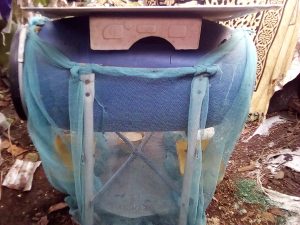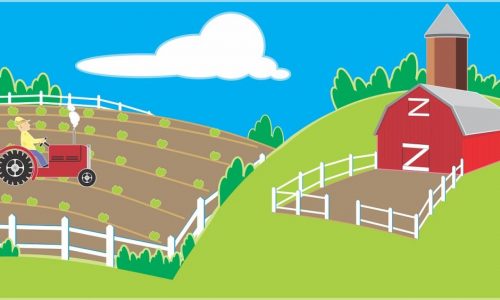The Stratipod Project
A revolutionary invention in black soldier fly micro-farming and social entrepreneurship
The Black Soldier Fly (BSF), scientifically referred to as Hermetia illucens, is an insect belonging to the Stratiomyidae family that is able to consume organic waste in its larvae stage to build up a nutrient rich biomass. These larvae are then sold as a substitute of protein and fat sources used in production of animal feeds.
The Stratipod is a novel device that will allow a farmer to build and maintain a colony of BSF, using locally available organic waste as the raw material source, in order to harvest larvae for profit and income generation. The proposed project will involve distribution of 100 Statripods to the rural residents in the target group between 18-35 yrs of age at a determined payment plan. In addition, the project will include coordinated distribution of the organic waste raw material to each recipient of the Stratipod, access to a market for the larvae they produce and free all round training from the beginning of the project to harvest stage. The project envisions each Stratipod as a micro-farm and self-employment unit that will generate self-determined income for each recipient at an investment payback period of 5 months. Therefore, each of the 100 Stratipods will essentially be part of an integrated network of BSF Micro-farms coordinated by the project’s central program to produce maximum impact on the target community.





Project Highlights
- Social Entrepreneurship
- Food Security
- Organic Waste Recycling
- GHGs Emissions reduction
“The Stratipod is a standalone micro-farm that innovatively combines all the stages and infrastructure of the Black Soldier Fly (BSF) rearing process into 1 portable unit.”
a Proprietary InspCorp Innovation
The Stratipod
The Stratipod is a standalone micro-farm that innovatively combines all the stages and infrastructure of the Black Soldier Fly (BSF) rearing process into 1 portable unit. The name Stratipod comes from the family name of the Black Soldier Fly, Stratiomyidae. BSF Larvae are a high-value feed source containing about 42% crude protein and around 29% fat. In addition, they are an attractive option for processing and value addition of
organic waste into feed biomass that can be re-integrated back into the food supply chain as animal feed.
The lifecycle of BSF involves 4 four stages: egg, larvae, pupa and adult and the cycle takes around 6 weeks. A BSF female adult usually lays about 500 eggs which hatch into young larvae after an incubation period of about 4 days. The BSF larvae are very voracious and have an insatiable appetite. They feed on organic matter and increase in body mass, effectively converting organic waste into edible biomass for animals. Under ideal feeding conditions, the larvae mature after six growth spurts (instars) within 3 weeks into the pupae stage. However, some of the mature larvae are usually harvested before the pupae stage characterized by the formation of a chitin encasing on the grub’s body which is usually indigestible by animals. The harvested larvae in this project will be processed at the project handling centre. Pre-pupae, the grubs in transition from larvae to pupa stage, usually migrate to a dry area away from the food source in preparation of pupation. The pupae stage takes least 14 days before emergence of the flies. The BSF adults start mating, 2 days after emergence, and have a lifespan of around one week. At this stage they only take water and rely on the fats built up during larval stage for survival. The female adults lay eggs, beginning another the cycle.
BSF farming involves accommodating and promoting ideal progression of the highlighted four stages of development of the BSF cycle. Hence, a typical BSF farm includes the following areas:-
- Hatchery: A dry and humid area for the female to lay her eggs using materials such as cardboard and an attractant to direct the flies where to lay their eggs.
- Lavarium: An area for the hatched young larvae to feed on the supplied organic waste and grow to maturity.
- Puparium: A dry area for the harvested pre-pupae to undergo pupation.
- Insectarium: An area for pupae to hatch into adult flies, mate and lay eggs. Should have water points to prolong the lifespan of the flies.
The Stratipod innovatively combines all of the four described areas into a standalone device with a volume capacity of holding at least 50 L of organic waste material that is about 30 kg at a relative density of 0.6. That is enough to build up and sustain a BSF larva colony within the first 20 days during the start-up phase, when the maximum colony population has been achieved, the Stratipod can take at least 15 L volume of organic waste which is about 9 kg of material daily.
The Stratipod places its hatchery over the humid environment of its designated lavarium. The lavarium features a double 45 degree ramp to facilitate movement of pre-pupae out of the food space within the larvarium. As they craw out through the 45 degree ramps, the pre-pupae fall into the puparium space of the Stratipod. This constitutes a self-harvesting mechanism for pupa which ensures a natural flow of the lifecycle and a hassle free process for the micro-farmer. At the puparium, the harvested pupa have a dry conducive environment for pupation. The insectarium is located under the puparium and lavarium in an open space greenhouse enclosed in a net. After emergence, the new adult flies can fly down from the puparium and into the insectarium green house where they will have full access to natural sunlight and drinking water allowing for mating and a prolonged lifespan of the adult flies. Egg laying females are then attracted back through the puparium and into the lavarium by the scent of the decaying matter in the lavarium where they can freely lay their eggs in the hatchery area.
At full potential, the Stratipod will take about 9 kg of material daily to feed colony of voracious larvae within the lavarium. At 40% moisture, this corresponds to 5.4 kg dry weight of organic material. Taking about 3 kg/day for fattened larva feed and the rest 2.4kg/day for the development of pupae and at a FCR of about 2.15, it amounts to a biomass increase of 1.4 kg/day in the larva colony. This amounts to a cumulative mass of 19 kg of full grown larva after 14 days of development ready for harvest.

Project Objective
The goal of this project is to bridge the existing urban-rural gap in Kenya. The project will work towards realization of the stated goal by implementing measures that will achieve and promote rural development as a solution to the urban-rural divide. In order to promote rural development and consequentially narrow the urban-rural gap in Kenya, the proposed project has set out the following objectives:-
Objective 1: To increase the number of self-employment business units within the target community by 100.
Objective 2: To generate at least 3 tonnes per month of nutrient rich feed into the target community’s food supply chain.

Target Group
This project targets the participation of 100 Kenyan youths between the ages 18-30 yrs that are based in the country’s rural areas. The proposed integrated micro-farm will be established in any community residing within a designated rural area or village in Kenya. 100 individuals from the target demographic, preferably a 50-50 distribution between male and female participants, will be selected as participants to the project. The project will preferentially consider individuals in the target group that are unemployed. However, employed youths seeking to venture into self-employment in search for fair wages and increased income will also be considered.

Deliverables
The proposed project will begin with a start-up phase in the first month of its implementation and then progress to the operation phase that is expected to be continuously increasing to maximum production potential within 2 months from its implementation stage. At full operation, the proposed project will achieve the following results:-
Increased number of self-employment business units within the target community by 100 by planting 100 operational Stratipods within a month of the project initiation.
Increased quantity of food in the local food supply chain of the target community by at least 3 tonnes per month within 3 months of start-up phase.
At least 2 more investment ventures in the target community created by outsourcing the collection and transport of organic waste at project initiation.

“This sections highlights the functionality of the Stratipod in relation to its structural parts.”
How it works
The Stratipod is made mostly from recycled materials that facilitates its low unit cost of production.
The Stratipod is structurally composed of the pod and its auxiliaries. The pod is accessed mainly through the pod door that is attached to an overlapping roof structure that protects the inner space of the pod from the elements. The pod door is hinged to open outward to a 120 degree angle to allow access to the pod during inspection, feeding or when accessing the hatchery. The pod has two other access points through the sides called the side access that allows the user to inspect and clean the prepupae spaces at the side of the pod.
The pod is elevated 1m from the ground by the mounting structure that is designed to expand the base area for stablility in addition to create an appreciable space beneath the elevated pod. This space is enclosed with a polyester net to form an insectarium with access to direct sunlight that is suitable for breeding of the adult black soldier flies.
The stratipod has two puparium spaces located beneath the prepupae spaces within the pod. During migration of the prepupae for the pupation, the prepupae leave the lavarium and climb up the selfharvesting ramps and fall into the prepupae spaces before crawling through the pod exists and fall into the puparium located just below them.
The pupariums store the pupa during the pupation stage and upon emergence, the flies leave the puparium to go into the insectarium area for breeding. After breeding, egg-laying females are attracted by the decomposition scent in the lavarium and fly into the pod through the prepupae exit spaces of the pod. Once inside the pod, the egg laying females are attracted to the hatchery where they lay their eggs. The eggs hatch after four days into tiny larva which fall into the lavarium where they continue to consume the organic waste, increase in body mass and are eventually harvested or allowed to transition into prepupae for the continuation of the life cycle and to increase the population of the larva colony in the Stratipod.
The video above features the interior of the pod, showing the organic waste in the lavarium, the self harvest ramps and the hatcherOnly takes a few seconds!
Project Stratipod Highlights
![]()
Social Entrepreneurship
The proposed project will involve distribution of 100 Statripods to rural residents in the target demographic between 18-35 yrs of age in the community of implementation. The project envisions each Stratipod as a micro-farm and self-employment unit that will generate self-determined income for each recipient at an investment payback period of 5 months.

Food Security
Each integrated network of the 100 BSF Stratipod Micro-farms has the potential of generating more than 3 tonnes of protein rich meal per month. This nutrient rich meal of BSF larvae has been demonstrated to be an attractive substitute to animal feed constituents that are often more expensive and in direct competition to human consumption. By feeding these 3 tonnes of generated nutrient rich animal food into the local food supply chain, this project envisions an increase in livestock yield and productivity within the local community motivated by higher availability and affordability of animal feeds.

Green initiative
Research by Jennifer Anderson et. al. has shown that processing organic wastes by insect larva enables 41% of the feed carbon in the waste to be stored as insect
body mass in the forms of protein, edible oil, and chitin. This results in 70% less carbon based GHG emissions than recycling the organic matter aerobic and anaerobic composting. The Stratipod facilitates the processing of organic wastes by BSF larva hence promoting up to 70% reduction of the 3.5 Gt CO2 payload injected into the atmosphere through contemporary methods of handling organic waste, as reported by the Food and Agriculture Organisation in 2011.